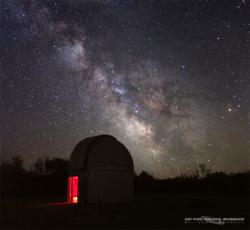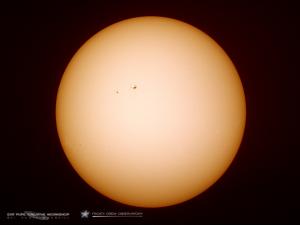
Public Stargazing
- Where:
- Frosty Drew Observatory
- When:
- Friday May 16, 2014 at 7:00 p.m.
- Cost:
- $1 Suggested Donation per Person
Tonight's forecast is calling for clouds, rain, fog, wind, and a possible t-storm. This will unfortunately keep the observatory telescopes closed. The 96% waning gibbous Moon will rise at 10:09 p.m. and would have given us a small window of dark skies before significantly illuminating the sky. We plan to open the Sky Theatre from 7:00 p.m. – 9:00 p.m. Using astro-photos taken with the Frosty Drew telescope, we will have an open discussion on some of the objects we would have observed tonight. Stop in for some astronomy geekage as we reminisce about cloud free nights that frequent us in Charlestown.
-------------------------------------------------------------------------
Weekly Happenings
Scott MacNeill
Friday, May 23rd marks the start of Memorial Day weekend signaling the opening of all things Summer. Among all the awesome happenings, Frosty Drew Observatory will be bringing back our safe Solar Projection program. Starting at 6:00 p.m. every summertime Friday, we will project live views of the Sun onto screens in the Observatory and on the big screen in the Sky Theatre. Using a special telescope filter we will observe the solar photosphere and any sunspots that are visible. The current sunspot cycle (Cycle 24) is just about to leave its maximum period (Solar Maximum) and will offer us another Summer of excellent sunspot viewing. We will keep the telescope on the Sun until sunset after which, we will switch over to stargazing mode. Join us every Friday (weather permitting) through September to catch a glimpse of the Sun's photosphere.
In February 2004, a European Space Agency (ESA) mission named “Rosetta” left planet Earth for a ten year mission to the outer solar system with Comet 67P/Churyumov-Gerasimenko as a final destination. Rosetta's mission will be to rendezvous with Comet 67P in May 2014, spending the next three months approaching the comet's nucleus while taking initial images of the comet to better understand its size, shape, and rotation. Come August 2014, Rosetta will close in on the comet, performing surveys to better understand the comet's angular velocity, spin-axis orientation, and other characteristics, eventually achieving orbital insertion around the comet's nucleus at a distance of 15.5 miles. Rosetta will then begin mapping the comet's nucleus in detail, identifying five potential landing sites. That's right, landing sites! 
In November 2014, Rosetta will release its lander module from a distance of 0.6 miles out and land on the comet's nucleus. Once attached to the comet, the lander will anchor itself in place and start sending back high resolution images and readings of the comet's ices and organic surface. Rosetta will spend the following year with Comet 67P as it orbits the Sun, monitoring the dramatic changes on the comet's surface as the icy nucleus makes its journey towards and away from the Sun. This journey will make Rosetta the first spacecraft to orbit a comet's nucleus and the first to land, in a controlled fashion, on a comet's surface. Learn more about the exciting ESA Rosetta mission. Woot!

